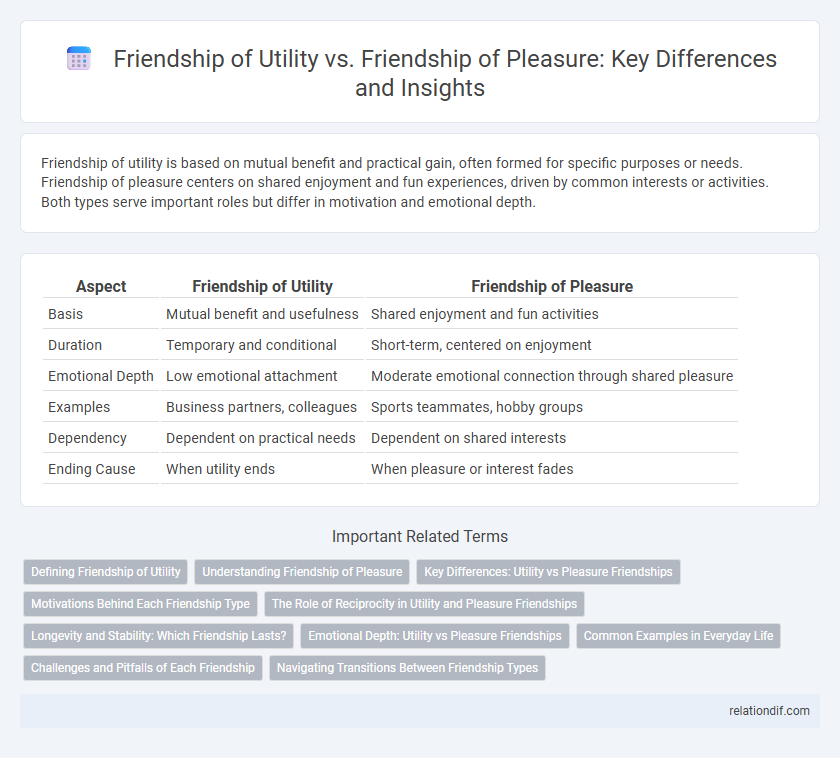Friendship of utility is based on mutual benefit and practical gain, often formed for specific purposes or needs. Friendship of pleasure centers on shared enjoyment and fun experiences, driven by common interests or activities. Both types serve important roles but differ in motivation and emotional depth.
Table of Comparison
| Aspect | Friendship of Utility | Friendship of Pleasure |
|---|---|---|
| Basis | Mutual benefit and usefulness | Shared enjoyment and fun activities |
| Duration | Temporary and conditional | Short-term, centered on enjoyment |
| Emotional Depth | Low emotional attachment | Moderate emotional connection through shared pleasure |
| Examples | Business partners, colleagues | Sports teammates, hobby groups |
| Dependency | Dependent on practical needs | Dependent on shared interests |
| Ending Cause | When utility ends | When pleasure or interest fades |
Defining Friendship of Utility
Friendship of utility is a relationship based on mutual benefits where individuals seek help, resources, or advantages from one another. This type of friendship is often temporary and functional, centered on practical interests rather than emotional connection. It contrasts with friendships of pleasure, which are driven by shared enjoyment and emotional satisfaction.
Understanding Friendship of Pleasure
Friendship of pleasure is based on the enjoyment and satisfaction derived from shared activities and mutual interests, often driven by emotions and immediate gratification. This type of friendship tends to be more dynamic and fluctuates depending on changing preferences and circumstances. Understanding friendship of pleasure involves recognizing its inherently transient nature, where bonds may weaken if the source of enjoyment fades or diverges.
Key Differences: Utility vs Pleasure Friendships
Friendships of utility revolve around practical benefits, serving specific needs or goals, such as business partnerships or networking contacts, whereas friendships of pleasure center on shared enjoyment and mutual entertainment, like hobbies or leisure activities. Utility friendships tend to be more transactional and dependent on circumstances, often dissolving when the utility fades, while pleasure friendships thrive on emotional connection and ongoing shared experiences, fostering greater personal satisfaction. Understanding these distinctions helps in recognizing the varied purposes friendships serve and in nurturing meaningful, balanced relationships.
Motivations Behind Each Friendship Type
Friendship of utility is motivated by practical benefits and mutual gain, often centered on specific goals or needs, such as business partnerships or collaborative tasks. Friendship of pleasure arises from shared enjoyment and emotional satisfaction, driven by common interests and activities that bring joy and relaxation. Understanding these motivations helps distinguish relationships based on personal advantage from those formed through genuine companionship and shared experiences.
The Role of Reciprocity in Utility and Pleasure Friendships
The role of reciprocity in friendships of utility and pleasure is fundamental, as these relationships often depend on mutual benefit and shared enjoyment rather than deep emotional bonds. Utility friendships thrive when both parties exchange valuable resources or services, ensuring the relationship remains advantageous for each individual. Pleasure friendships rely on reciprocal interactions that foster fun and companionship, maintaining the connection through enjoyable shared experiences.
Longevity and Stability: Which Friendship Lasts?
Friendship of utility, based on mutual benefit, often lacks longevity due to its dependence on external advantages, while friendship of pleasure can be more stable but tends to fluctuate with changing interests and emotions. True long-lasting friendships combine elements of both utility and pleasure but are primarily grounded in trust, shared values, and emotional support. Stability in friendship arises from consistent commitment and genuine connection beyond transient benefits or fleeting enjoyments.
Emotional Depth: Utility vs Pleasure Friendships
Friendships of utility often lack emotional depth as they are based on practical benefits rather than genuine feelings, leading to transactional interactions. In contrast, friendships of pleasure are founded on shared enjoyment and common interests, fostering a higher level of emotional connection and spontaneity. Emotional depth in pleasure friendships allows for more authentic expressions of joy and vulnerability, unlike utility friendships which remain surface-level exchanges.
Common Examples in Everyday Life
Friendships of utility often form between coworkers collaborating on projects or neighbors sharing resources, where practical benefits drive the connection. Friendships of pleasure emerge in social settings like sports teams, hobby groups, or casual outings where shared enjoyment fosters bonds. These types illustrate how friendships may prioritize function or fun depending on mutual interests and situational context.
Challenges and Pitfalls of Each Friendship
Friendship of utility often faces challenges due to its reliance on mutual benefits, making it vulnerable to collapse when practical advantages disappear, while friendship of pleasure can be unstable as it depends heavily on shared enjoyable experiences that may change over time. Both types risk superficiality and lack of deep emotional connection, leading to potential misunderstandings and disappointment. Maintaining trust and genuine concern is difficult, as these friendships may prioritize personal gain or fleeting enjoyment over long-term loyalty and support.
Navigating Transitions Between Friendship Types
Navigating transitions between friendship of utility and friendship of pleasure requires recognizing shifting personal needs and shared interests. Friendships of utility are primarily goal-oriented and benefit-driven, while friendships of pleasure emphasize enjoyment and emotional connection. Understanding these dynamics helps maintain balance and adapt interactions as priorities evolve.
Friendship of utility vs Friendship of pleasure Infographic

 relationdif.com
relationdif.com